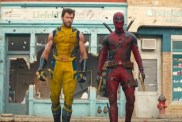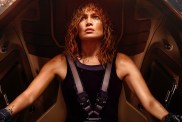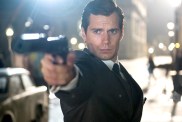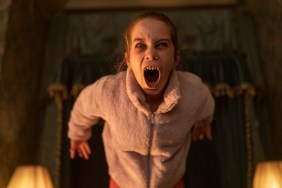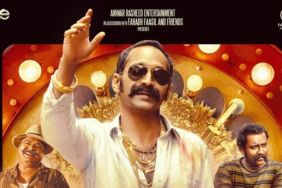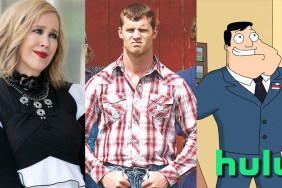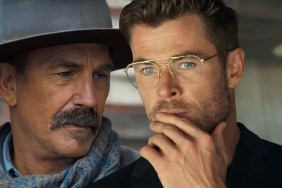
In the film, Long plays a podcaster who specializes in interviewing “interesting” people for his program. His travels carry him to Canada where he meets an older gent (Parks) with a helluva history and who packs one insane agenda: He intends to turn Long’s character into a walrus. Co-star Genesis Rodriguez told me before my chat with Smith that it’s no secret Parks’ character succeeds, my only question is: Upon walrus transformation – where the hell does the story go from there?
My conversation with Smith begins with a discussion about the film’s music as we share a mutual friend in composer Christopher Drake (the man behind the stunning work in the Batman animated films). Through this introduction, Smith drops some clues as to where the film twists and turns and touches heavily on the tone – which brings me back to this ’80s horror thing… I’ll let Smith explain more.
Ryan Turek: Chris is incredibly talented, I’m so glad you brought him on board this project.
Kevin Smith: If you see the trailer, he’s the star of the trailer. Well, the actors are the stars, of course, but his music is the second half of the trailer and Chris – you know, this is a Smodcast picture and every element of the movie has something to do with the podcast we’ve been recording over the years – and Drake was on “Fat Man on Batman” and we got along very well. While we were talking, I found out he was a horror movie buff. And I love, love, love his score for The Dark Knight Returns animated film. I’ve loved every piece he’s done for the DC universe, but I thought that was exquisite. Like some Hans Zimmer stuff. I told my producer, this guy is doing cinematic, theater-worthy stuff in the world of animation. He hasn’t gotten tapped for live-action, if you become that bridge, he’ll give you the best work of his life. That’s what Drake did – he pulled it out of his heart, soul, ass…everywhere. It’s an insanely wonderful score. On “Fat Man on Batman” we talked about horror movies at one point and the John Carpenter scores and it evolved. Initially we talking about a Carpenter, synth-y thing. We listened to the Halloween III record and played it to death. But then I was thinking something stark like The Texas Chain Saw Massacre – he sent me this piece and was like, “I don’t think you’re remembering this right.” And I said, you’re right. Then he said, “Why don’t we just go with a monster movie?” I thought, yeah, something elegant. It’s based on the look of the film which is something elegant. Originally we were going to do something hand-held and punk rock and synth, but once the movie was done, it was all on rails with a dolly and elegance, it felt like the score needed to be elegant. That’s what Drake did.
Turek: The one moment of the trailer that chilled me was the POV shot from the water. I so wanted to see a reveal of Justin’s “final form.” So, it looks like you’re really going full bore into horror mode where Red State, I think, was on the fringe, but not necessarily “horror.”
Smith: I’m very comfortable saying it’s a horror film and that it’s a genre film. I’m sure some people will saying that I’m doing it wrong or it’s not horror. There’s always someone telling me that I’m doing something incorrectly. [laughs] There’s always going to be a little resistance and when there’s resistance I don’t want to shove it down someone’s throat, but this to me definitely feels like a horror movie. It just has humor to it. The model for me is An American Werewolf in London. When I was a kid, I saw that film and I was like, this horrifies me, but every so often, it let the air out a little bit. The decaying Griffin Dunne holding up the Mickey Mouse and saying, “Hi, David!” – you didn’t see that in a horror movie before. You remember the things of your childhood and you carry them with you like herpes for the rest of your life. That movie was a safe haven for me. The built you up, then let you off the hook a little bit which is even worse than flat-out horror, horror, horror. I like that model and approach. When I gave a shot at horror with Red State it was a little bit of that. This is more… It’s tough to say it’s comedic, it’s just madness. It’s someone who is going mad with someone who is already mad and it’s this cat and mouse game for the first half hour. Then it’s a mystery for the next half hour and then for the last half hour it’s this adventure movie from a completely different universe. It’s a strange movie, but it holds together because of the performances. Nobody winks at the camera, but we do let people know we know how f**king stupid it is periodically, but everyone plays it so earnestly, I think it’s going to be cool.

Smith: Yeah, read one guy say that, too. Another guy was like, “This looks like Human Centipede!” but we say on the podcast, where it was devised, we said it was a cuddlier version of The Human Centipede. Moreau, the idea of taking a human and turning them into an animal, the Chimera approach, that was definitely there, so it’s a movie that’s informed by the movies I loved growing up. I never thought I would grow up to make them because I do comedy and it felt right.
Turek: Well, what are you finding in yourself now doing horror? Are you surprising yourself in any way taking on this genre?
Smith: Yes, man, absolutely. I was shocked by day two how beautiful it looked. James Laxton’s our d.p. and originally we were going to do it hand-held. And we’re out there shooting in North Carolina and Homeland was down and Banshee was down – shows that were shooting out there. So, we were able to cherry-pick their crews and they’re making Emmy-winning television and doing it at TV speed, so you’re going to get great-looking stuff and they move fast. We had this Philip Dann and you know how good you have to be at being a dolly grip in order for me to be talking about you and remembering your name? This man was like a surgeon with a dolly. He threw down rails and if there was ever a bump, he’d hammer it out. He made day one of shooting amazing. So, I turned to Laxton and said let’s get rid of steadicam and hand-held so we can be on rails and keep the film constantly flowing. Because of that, the movie ends up looking better. And then Laxton said, let’s go 2.35:1. Let’s go for it. Because he pushed the framing that wide, I said, let’s compose this classically. Instead of the quickest way out of problem, I looked to the masters. What’s one of my favorite horror movies? The Shining. There’s ton of even composition throughout and you see that in our film. I can’t make The Shining but I can frame a shot that will remind me of it. There are other moments, too, like the heartbeat where you’re with Scatman Crothers, we kick that into the movie. If you’re going to steal, steal from the masters. When I look at Tusk it reminds me of the movies I grew up with and that makes me happy. It’s worth the watch. I don’t know if people will love it or hate it, but they’ll be like, “Well, that was an experience.”
